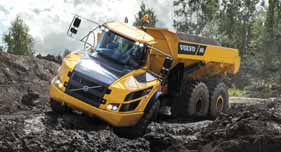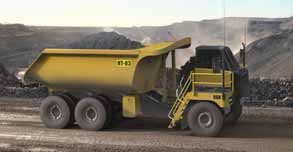
Komatsu 730E-8 AC.
Builders Add Big-rig Features to Their Smaller Haulers
Lower-capacity rigid-body trucks are benefitting from the engineering design
principles and upgraded feature sets of their bigger stablemates, while articulated
dumpers continue to get tougher and more agile

Komatsu Flips the Switch
on a New AC-drive Model
Komatsu said the AC-drive 730E-8 offers
higher haul speeds and simpler maintenance requirements than the DC-drive version, and is designed and manufactured to
the same engineering principles as its
ultra-class mining trucks. It is powered by
a Komatsu SSDA16VV159/QSK50 diesel
rated at 2,000 hp (1,492 kW).
According to the company, the AC-drive system is lighter than either mechanical or DC transmission systems, provides faster acceleration and higher top speeds, and delivers more reliable performance with easier maintenance. Top speed of the 730E-8 is reported at 64 km/h and it can handle effective gradients up to 12%. The AC control system offers independent control of the rear wheel motors, providing improved traction in wet and slippery conditions, reducing tire wear and improving operator confidence.
The truck’s GE35B AC-drive wheel motors, designed collaboratively by Komatsu and GE Mining, have no brushes—thus eliminating flashover—and higher thermal capacity. A 2,760-kW retarding system provides advanced braking capacity, giving the ability to handle steep continuous descents and sharp switchbacks.
Komatsu claims the 730E-8’s “bolttogether” design makes field assembly and disassembly less complicated, reducing the need for skilled technicians in the site assembly process. The 730E-8 also incorporates an easily removable powertrain module, further reducing the time needed to complete on-site maintenance.
Hitachi’s 70-ton Rig has
Extensive Enhancements
Hitachi Construction Machinery introduced
the latest version of its 70-t (63.5-mt) payload EH1100 rigid-body truck at ConExpo
2014, featuring improvements to the operator environment and machine serviceability, as well as enhanced remote monitoring
capability, among others.

Under the hood, two Environmental Protection Agency (EPA) Tier 2/European Union (EU) Stage II engines are available: For the market outside of North America, customers can choose between an MTU Series 2000 or Cummins QSK23 diesel. Within North America, only the Cummins QSK23 engine is offered.
An Allison H6620A automatic transmission provides improved shift quality, less shifting when empty, and upgraded components—all resulting in longer life before rebuild, according to Hitachi. A transmission Optimum Shift Range has been developed to automatically alter the transmission range according to payload data provided by an onboard weighing system. All EH1100-5s are equipped with a DLU (data logging unit) to enable remote monitoring of the truck via satellite, Wi-Fi and Wenco.
The truck body is designed to a volume of 41.5 m 3 and has a flat floor-plate for more control of material shed while dumping.
In the cab, the new EH1100-5 is equipped with a 25-cm (10-in.) LCD screen—similar to Hitachi’s larger mining trucks and shovels—displaying performance and systems condition information. Truck systems communication via CAN bus allows rearview camera monitoring through the LCD display and reduces the amount of wiring required throughout the truck.
Many steering and brake system valves and test ports have been relocated from the mid-frame of the truck to the service deck of the truck for easier service and troubleshooting access. The steering filter is now located outside of the frame allowing service personnel the same ground level service access as is offered with the hoist filter. The two main batteries have been moved to the front bumper for ground level access. Two body prop pins replace the single prop cable that was previously the only means of propping the body up. Two diagonal stairways now offer easier access to the operators cab and to the service deck. A mechanically hinged hand rail at the front of the cab can be positioned to provide the operator with optimum haul road visibility while the truck is in operation, or positioned to provide fall protection during cab area service.
Two Upgraded Models
from Cat
Cat’s new 770G and 772G off-highway
trucks feature claimed major advancements
in emissions technology, transmission and
traction control systems; frame, drive-train,
and cooling system enhancements; added
operator amenities; and serviceability
improvements. Nominal rated payload capacities are 40 and 52 t (36.3 and 47.1 mt),
respectively, for the 770G and 772G.

The haulers are powered by Cat C15 (770G) and C18 (772G) engines, with net power ratings of 477 (770G) and 550 (772G) hp (356 and 410 kW). Available in Tier 2/Stage II, Tier 3/Stage III, and Tier 4-Final/Stage IV configurations, the engines can be programmed to achieve specific fuel economy goals. Two programmable modes are available—Economy and Adaptive Economy. Economy Mode lets the customer select a derate value between 0.5% and 15%. At the touch of a button, Economy Mode applies steady power deration across all portions of the haul cycle. With Adaptive Economy Mode, the truck monitors power demand, delivering fuel savings when possible and horsepower when needed, to optimize fuel economy throughout the haul cycle.
A new transmission control system called Advanced Productivity Electronic Control Strategy (APECS) provides a number of benefits, according to the company, including improved shift quality, faster acceleration, better speed on grade and faster cycle times.
An optional advanced traction-control system uses the service brakes instead of the park brake components to modulate wheel slip. This change in design makes the system more responsive to traction loss in the lower speed ranges, and improves speed on grade in wet, slippery conditions.
Frame designs for the 770G and 772G have been modified to more precisely balance weight and durability requirements, providing frames tailored to the truck’s payload capacity. Welds in critical stress areas are double-sided and ultrasonically tested to ensure integrity. High-strength steel is used throughout the frames to absorb the stress of impact loads, while box-section construction manages torsion loads.
The 770G and 772G now come standard with VIMS 3G, Caterpillar’s Vital Information Management System, Truck Production Management System (TPMS), TMPH (Ton Mile Per Hour)/TKPH (Ton Kilometer per Hour) tire management system, and Product Link (standard or cellular).
Komatsu ADT Brings Higher
Payload, Body Capacity
In September, Komatsu introduced its
HM300-5 articulated dump truck, featuring a net 324 hp (242 kW) from a
Komatsu SAA6D125E-7 EPA Tier 4 Final
emissions certified diesel.

Through body design optimization, the HM300-5 has increased body capacity and payload. Offering a 28-mt (31-t) payload and a gross vehicle weight of 53,475 kg (117,892 lb), the HM300-5’s loading height matches with 30–60-t hydraulic excavators or 5–7.5-yd 3 wheel loaders. Two singlestaged body lift cylinders provide a 70° dump angle. Selectable working modes allow the operator to choose between Economy and Power modes to tailor machine performance to the application or work conditions.
The HM300-5 features the Komatsu Traction Control System, which automatically provides optimum traction when operating in soft ground conditions. The HM300-5 also has been enhanced with Komatsu’s Advanced Transmission with Optimum Modulation Control System, providing a six-speed, fully automatic transmission that uses an advanced electronic system to eliminate shift shock and torque cutoff to improve operator and engine efficiency. It automatically selects the ideal gear based on vehicle speed, engine rpm and the shift position chosen. A large automatic retarder allows the operator to select the optimum operating speed on downhill travel and fully loaded hauls, controlling acceleration generated by the grade of the slope.
An integrated Payload Meter (PLM) is now standard on the HM300-5. PLM data is also transferred via KOMTRAX and can be accessed over the Web.
The new model has a lightweight fiberglass engine hood, increased cooling capacity, and two standard hydraulically driven auto-reversing fans to help keep the radiator and charge air cooler clean. The cab tilts rearward for easy access to the transmission and an electrically powered tilt function is now standard.
The machine is equipped with Komatsu’s EMMS (Equipment Management Monitoring System), which has enhanced diagnostic features that give the operator and technicians greater monitoring and troubleshooting capabilities; and also features the latest KOMTRAX remote monitoring technology.

Volvo G-Series ADTs Have
Expanded Feature Set
Volvo Construction Equipment’s new GSeries articulated haulers—the A25G,
A30G, A35G, A35G FS, A40G and A40G
FS—are all powered by turbocharged sixcylinder Volvo engines that have been
redesigned to comply with Stage IV/Tier 4
Final emissions regulations.
The oil-cooled wet multiple-disc brakes previously used on the A35 and A40 models have been added to the A25G and A30G, reducing maintenance costs and increasing uptime, even on muddy or dusty job sites. Automatic traction control (ATC) and unique differential locks are standard on all G models. The ATC system automatically switches between drive combinations of 6 x 6 and 6 x 4 to ensure lower fuel consumption or provide maximum traction when needed. If necessary, all differentials can be fully locked, causing all wheels to rotate at the same speed for maximized traction in slippery conditions. With the A35G FS and A40G FS, full hydraulic suspension on all wheels increases productivity and makes for a more comfortable ride.
The A35G, A35G FS, A40G and A40G FS can be equipped with Volvo’s onboard weighing system. On FS models, the system uses full suspension pressure sensors to monitor weight, relaying information to load-data software integrated into the machine’s electronics.
These machines come standard with CareTrack, Volvo CE’s telematics system. Accessed remotely, CareTrack provides machine information such as fuel consumption and service reminders that allow improved planning and operation.
The Contronics system continuously monitors fluid levels and relays diagnostic information to a screen in the cab, providing warning messages to alert the operator to problems early on.
G-Series haulers, according to Volvo, are designed for safe and easy maintenance with a front grille that swings down and functions as a service platform with anti-slip steps. The hydraulic tank, after-treatment system, muffler, fuel tank and fill fitting have all been relocated to more intuitive locations.
 Loadpro X60. Loadpro, an Australian company, has developed the X60—a 60-mt-payload hauler that, according to company founder Ron Schliebs, employs a different approach to meet critical design and application targets. The X60’s design criteria, said Schliebs, demanded overall vehicle dimensions and a turning radius that would allow it to maneuver on restricted-width haul roads; sufficient power, traction and braking capacity to comfortably handle uphill or downhill grades up to 12%; lower operating costs per ton-mile or ton-kilometer in comparison with conventional trucks operating in similar conditions; and lessbut-easier maintenance than that typically required by modified on-highway, off-highway or articulated trucks. The X60 is designed specifically for extended hauls up to about 30 km (18 mi) in distance. The truck’s design includes a number of major components—including cab, engine, transmission and hydraulics—from Caterpillar, sourced through Cat’s OEM Solutions Group. Axle and suspension components are obtained from German suppliers. In order to reduce maintenance costs, time and resources, the engine is mid-mounted to allow quick and direct removal from the truck for replacement, and suspension parts can be “man-handled” by workers without need of specialized lifting equipment. A relatively long wheelbase and a low center of gravity, coupled with a roll stabilization system, provides for enhanced operational safety as well as the ability to accommodate high-volume bodies for coal haulage or water spraying. Schliebs noted that the X60 in cabchassis configuration, minus tires, can be shipped from the factory to the mine site in a standard 40-ft container. Once on site, roughly 100 man-hours would be required to fully assemble the truck. X60 prototypes are currently undergoing field trials at Indonesian and Australian locations, and production units are scheduled for release to the market in late 2014, according to the company. |